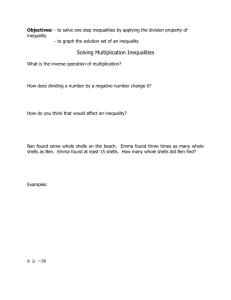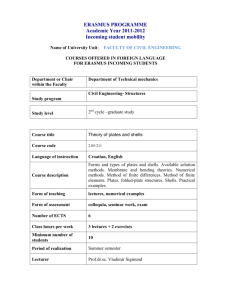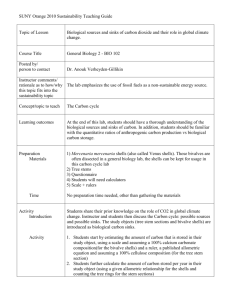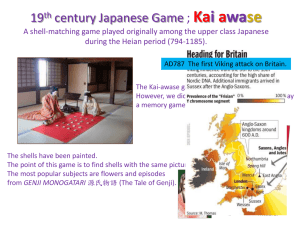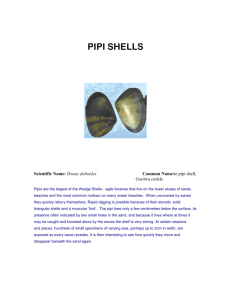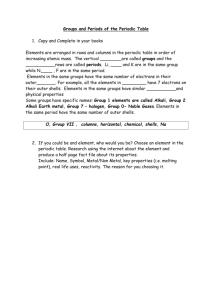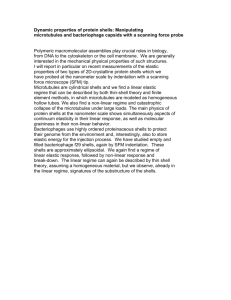student objectives - National Museum of Natural History
advertisement
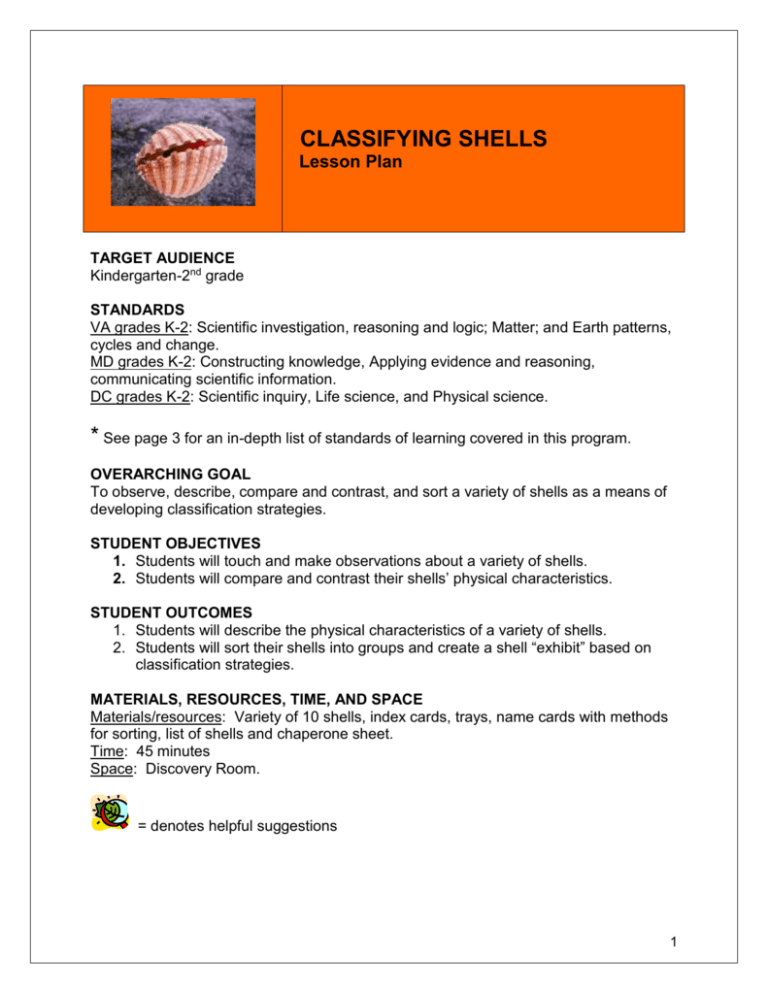
CLASSIFYING SHELLS Lesson Plan TARGET AUDIENCE Kindergarten-2nd grade STANDARDS VA grades K-2: Scientific investigation, reasoning and logic; Matter; and Earth patterns, cycles and change. MD grades K-2: Constructing knowledge, Applying evidence and reasoning, communicating scientific information. DC grades K-2: Scientific inquiry, Life science, and Physical science. * See page 3 for an in-depth list of standards of learning covered in this program. OVERARCHING GOAL To observe, describe, compare and contrast, and sort a variety of shells as a means of developing classification strategies. STUDENT OBJECTIVES 1. Students will touch and make observations about a variety of shells. 2. Students will compare and contrast their shells’ physical characteristics. STUDENT OUTCOMES 1. Students will describe the physical characteristics of a variety of shells. 2. Students will sort their shells into groups and create a shell “exhibit” based on classification strategies. MATERIALS, RESOURCES, TIME, AND SPACE Materials/resources: Variety of 10 shells, index cards, trays, name cards with methods for sorting, list of shells and chaperone sheet. Time: 45 minutes Space: Discovery Room. = denotes helpful suggestions 1 PROCEDURE Welcome: Scientist Discussion (2 minutes): Teachers and students are welcomed. The lesson begins with the instructor referencing a scientist in the museum who studies and collects animals that live in the ocean: Zoologists (invertebrate zoologists). Students will be told that they will practice being Zoologists in today’s lesson as they explore different shells. The role of a Zoologist and important scientist skills – using their sense of “sight” and “touch” will be discussed. Brainstorming (Activate prior knowledge – Help students become more comfortable providing ideas) (5 minutes): First: students will be asked to think about what people collect. What do they collect? Their answers will be documented. It will be explained to the students that scientists collect and study many different things (E.g. gems, animals, bones). Because there are so many things in the museum’s collection, the scientists have to put them into groups according to what they have in common. They need to “sort” or “classify” them. Finally, these groups are displayed in “exhibits”. Second: students will be told that they are going to look at different shells in the collection. They will use their eyes and hands to describe the shells. Modeling (Reference for Small Group’s Activity) (3 minutes): To help provide a model for the small group’s activity, the instructor will have the students (as a group) describe a shell. What do they “see”? (E.g. size, shape, color) How does it “feel”? (E.g. bumpy, rough, smooth) It will be explained that for their next activity they will explore a tray of shells. Their job as scientists is to describe the shells. Helpful Suggestion: Remind the students that there is no RIGHT answer and that it is important to work as a team. They should discuss with their classmates, listen and share their ideas. Keep describing until the time is up! Centers (Exploration and Discussion in Small Groups) (10 minutes): The students will divide into 5 groups. Each group will be given a tray of 10 shells. Each group will be managed by one chaperone/and or volunteer who will document the student’s ideas on an index card in order to not interfere with the flow of thinking. The students will be asked to examine the shells with their “eyes” and “hands”. Describe what they “see” (E.g. big, small, white, pointed, flat) and “feel” (E.g. rough, smooth, sharp, bumpy). Helpful Suggestion: Always ask the student’s for their ideas first, however, you may need to model effective thinking and/or problem solving. If the students seem stumped, focus their attention on the specimen. Encourage them to reflect on what they see and feel. Refer back to the group modeling if needed. 2 Reconvene (Generate Further Thinking – Observation Skills) (7 minutes): The students will reconvene as a group. The instructor will explain that they just completed their first step as scientists. Now they will have to decide on a way to sort/classify their shells, so that they can make an exhibit. The instructor will hold up one image of shells at a time (5 images total). Each image will display shells grouped according to size, shape, color, texture or pattern. (The images provide a visual and model for the students in creating their exhibits, it also provides an opportunity to reflect on and share some of their observations from the first activity.) Students will be asked to look at the shells: What is the same about the shells in the picture? What other colors or shapes of shells did they see during their first activity? Students will be told that for their next activity they will be scientists designing an “exhibit” of shells to display in the discovery room. Each group will be given a pack of descriptive cards, which will include size, shape, color, texture of pattern. As a group their task will be to choose a way to display their “shell exhibit”. They will then sort their shells on a tray and present it to their class. Centers (Exploration and Discussion in Small Groups) (8 minutes): Students return to their groups and work collectively to create an “exhibit” using a method of sorting. They will be encouraged to work as a team in making their decision and that it is very important to listen to one another. Everyone’s opinion is important, especially since there is more than one way to display the shells. Once completed, the group will write their names on an index card and place it by their display. Sharing (5 minutes): Trays with shell exhibits remain at the tables. Students will be given the opportunity to walk around the tables to observe the different ways their classmates chose to sort the shells. This will give the students an opportunity to visually see the exhibits, while providing them the simulation of walking around a museum and looking at exhibits. The students will be asked to give themselves a round of applause for being such excellent scientists and creating such wonderful exhibits. Closure (Thinking Post Lesson) (5 minutes) The instructor will reinforce the different ways students sorted their shells and will conclude the lesson by demonstrating another way to sort shells: univalves and bivalves. The instructor will model his or her own thinking process by explaining how he or she chose to sort the shells and why. The students will be encouraged, while visiting other exhibits in the museum, to look at the different ways scientists have sorted objects. If time permits the instructor will refer back to the group list of collections mentioned at the beginning of the lesson. Students will be asked to think about the collections they have at home. How can they sort their collections? What kind of exhibits could they create? The students and teachers will be thanked for coming, and also the chaperones for their assistance. Students are encouraged to come again! 3 STANDARDS VA grades K-1: K.1: a) Basic properties of objects observed. b) Observations made from multiple perspectives. c) Verbal description of objects are made. e) Objects grouped by physical attributes. g) Questions are developed from observations. j) Unusual and unexpected results in activity recognized. K.2: a) Use senses to gather information. b) Sensory descriptors are used (rough/smooth, etc). K.4: Students learn that physical properties of an object can be described. These properties include: a) Colors; b) Shapes and forms; c) Textures and feel; d) Relative size and weight. K.8: b) Students will investigate and understand simple patterns in the shapes and forms of common natural objects. 1.1: a) Differences in physical properties observed. c) Objects are arranged according to attributes and/or properties. d) Observations are communicated orally. f) Predictions are made based on patterns of observations. h) Inferences are made, conclusions are drawn. 2.1: Scientific investigation, reasoning and logic. MD grades K-2: Standard 1.A.1.a) Describe what can be learned about things by observing. b) Seek information through observations, exploration and investigation. Standard 1.B.1.a) Provide reasons for accepting ideas. b) Develop reasonable explanations for observations made, share ideas and listen to other’s ideas. Standard 1.C.1.a) Describe things as accurate as possible and compare observations with others. b) Describe and compare things in terms of texture, shape, texture, size, color. d) Work in a team, share findings with others, recognize that all should reach their own conclusions about findings. DC grades K-2: K.SI.3. Use senses to gather information. K.PS.3.2. Investigate and compare physical properties of objects. 1.1.1. Observe and sort objects as a way of categorizing some properties. 1.1.2. Make observations to seek answers to questions. 1.1.7. Describe and compare objects by shape, texture, size and color. 2.1.1. Describe objects and compare observations with others. 2.1.3. Demonstrate ability to work with a team. 4 CLASSIFYING SHELLS Background Information for the Teacher Scientific Method The scientific method is the way scientists learn and study the world around them. The basis of the scientific method is asking questions and then trying to learn the answers. Scientists begin by making observations about the world around them. These observations usually lead scientists to ask questions about what they see and know. After coming up with a question, scientists use what they already know to guess possible answers to their question. Next, they test one scientific guess, or hypothesis. Scientists can then determine an answer to their question based on their evidence. Hypotheses that scientists come up with must be able to be tested again, so that other scientists can repeat the test to confirm the outcome. Scientists can learn things from what other scientists have already questioned, tested, and answered. In this way, each scientist can build on what has been learned before by other scientists – or possibly begin with something that has never been questioned or tested! Image courtesy of http://www.biology4kids.com Classification Scientists name and group all the living things on Earth in an effort to make it easier for people throughout the world to use the same name for organisms. Over the years there have been many different ways of classifying, or grouping, things. Scientists are constantly revising classifications, sometimes every day! The currently accepted system of naming and classifying organisms is called binomial nomenclature, and was invented by Carl Linnaeus (1707-1778). According to this system, all organisms belong to a single Kingdom, Phylum, Class, Order, Family, Genus, and Species. Organisms are named by their Genus and Species, written: Genus species. 5 There are many characteristics of organisms that allow them to be identified and classified with other similar organisms. These characteristics may include outward appearance, internal morphology, genetic relatedness, and sometimes behavior and ecology. Shells and Mollusks Shells are made by animals called mollusks, and are part of their bodies. Mollusks have soft and fleshy bodies. In order to protect their soft bodies, they encase themselves in hard, external shells made of lime (calcium carbonate). They secrete this substance from a part of their bodies called the mantle. There are 110,000 species of living mollusks, and many, though not all, of these species have an external shell. Shells can often be used to help identify mollusks by species. Mollusk shells are very hard and act as protection. Many mollusks can seal their shells closed so that their soft bodies are protected within. Shells may also help prevent mollusks that live on land from drying out. The colors and patterns of shells may act as camouflage or warning. Mollusks live in many different environments, and can be sessile or may move in one of several ways. Some species of mollusks creep about on land, some live on top of or burrow into the ground sediments of fresh or salt water, and others swim freely about the ocean. Mollusks range in size from minute snails and clams, which are less than a centimeter in size, to the giant squid, which can reach 18 meters (60 feet) in length. Univalves and Bivalves The class of mollusks called Gastropoda includes snails and slugs. Gastropods may live on land, in fresh water, or in salt water. There are 90,000 living species of gastropods, making up 80% of living mollusk species. Not all gastropods have shells, but those that do have shells with only one part. Any animal with a shell that has only one part is called a univalve. The class of mollusks called Bivalvia includes clams, mussels, oysters, and scallops. Bivalves live only in fresh or salt water; there are no terrestrial bivalves. There are 15,000 species of bivalves, making up 13% of living mollusk species. All bivalves have shells that are made up of two parts, called valves. Bivalve shells are hinged and are held together by large bands of muscle. Bivalves’ bodies are soft and quite sensitive to irritation, so they secrete a mucous material called mother-of-pearl that hardens and lines the inside of the shell and helps protect their sensitive bodies. Univalve shell Image courtesy of http://www.manandmollusc.net Bivalve shell Image courtesy of http://users.actrix.co.nz 6 Glossary binomial nomenclature Noun. The scientific system of naming an organism using two terms, the first being the genus and the second the species. The terms are usually Greek or Latin and are written in italics, such as: Genus species. bivalve Noun. A class of mollusks with two shells. classify Verb. To arrange, organize, or order by classes. classification Noun. One of the groups, or classes, into which organisms may be or have been classified. ecology Noun. The science of the relationships between organisms and their environments. evidence Noun. Something that supports, proves, or indicates a theory to be valid. experiment Noun. A trial for the purpose of discovering something unknown. gastropod Noun. Any mollusk of the class Gastropoda, including the snails, whelks, and slugs, and many more similar animals. hypothesis (plural: hypotheses) Noun. A proposition given as an explanation for the occurrence of some specific occurrence. lime Noun. A white or grayish-white, odorless, lumpy, very slightly water-soluble solid, CaCO3 (calcium carbonate), that makes up the outside shells of mollusks. mantle Noun. A part of a mollusk’s body onto which they secrete the lime used to make their shells. mollusk Noun. Any invertebrate typically having a shell of one, two, or more pieces that wholly or partly enclose the soft, unsegmented body. morphology Noun. The form and structure of an organism. mucous Noun. A slimy mixture of water, electrolytes, skin cells, and other substances that is secreted by glands in mollusks that serves primarily to protect and lubricate the animal. observation Noun. An act of noticing, perceiving, regarding attentively, or watching. organism Noun. A form of life. scientific method Noun. A method of research in which a problem is identified, relevant data is gathered, a hypothesis is formulated from this data, and the hypothesis is tested. sediment Noun. A mineral or organic matter deposited by water, air, or ice that is often found at the bottom of liquid, such as on the bottom of an ocean or a river. sessile Adjective. Permanently attached, or not freely moving. shell Noun. The hard outer covering of a mollusk. terrestrial Adjective. Growing or living on land; not aquatic. univalve Adjective. Composed of a single shell. valve Noun. One of the two or more separable, hinged pieces making up certain shells. 7 Resources Suggested Web Sites: Smithsonian National Museum of Natural History Marine Science http://www.si.edu/marinescience/ Smithsonian National Museum of Natural History—Marine Science Station at Fort Pierce Species Inventory http://www.sms.si.edu/irlspec/index.htm Conchologists of America What is a mollusk? http://www.conchologistsofamerica.org/conchology/ Conchologists of America What is a shell? http://www.conchologistsofamerica.org/theshells/ Suggested Books: Arthur, Alex. (2000). Eyewitness: Shells. New York, NY: DK Children. Dance, S. (2002). Shells (Smithsonian Handbooks). New York, NY: DK Adult. Gilpin, Daniel. (2006). Snails, Shellfish, and other Mollusks. New York, NY: Compass Point Books. Parker, Steve. (2004). Eyewitness: Seashore. New York, NY: DK Children. Silver, Donald M. (1993). One Small Square Seashore. New York, NY: W. H. Freeman and Company. References: Bourquin, Avril. (N.D.). A Beginner’s Guide to the Mollusks. 20 Feb 2007. <http://www.manandmollusc.net/kid_zone.html> Dance, S. (2002). Shells (Smithsonian Handbooks). New York, NY: DK Adult. Gilpin, Daniel. (2006). Snails, Shellfish, and other Mollusks. New York, NY: Compass Point Books. Holley, Walter Dennis. (1994). Animals Alive!: An Ecological Guide to Animal Activities. New York, NY: Roberts Rinehart Publishers. Rader. (N.D.). Reasoning in Science. 14 Feb 2007. <http://www.biology4kids.com/files/studies_scimethod.html> 8 CLASSIFYING SHELLS Ancient Seas Exhibit Activity Sheet Name ________________________________________________________________ Locate a collection of shells within the Ancient Seas Exhibit. Draw four shells that you see in the boxes below. If any of the shells you drew are alike, circle them. How are they alike? ______________________________________________________________________ ______________________________________________________________________ How are the shells in the exhibit sorted? ______________________________________________________________________ ______________________________________________________________________ 9

